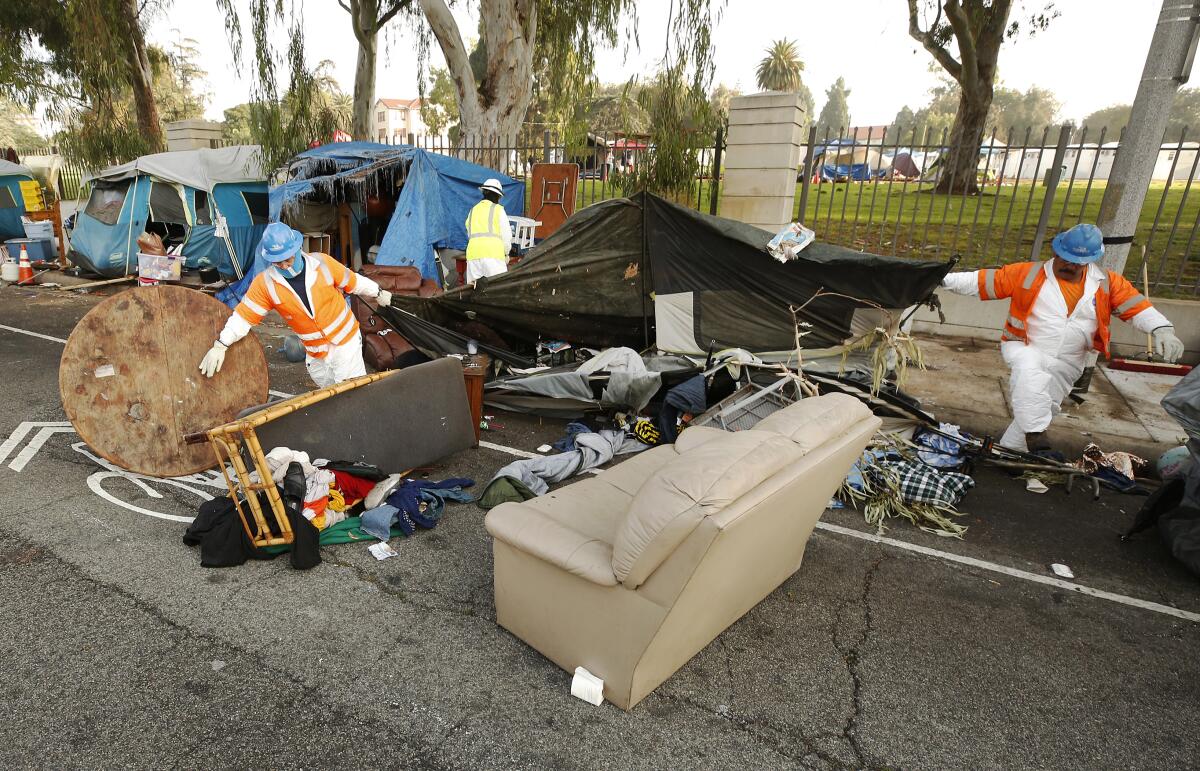Column: Newsom talked tough with mayors and supervisors on homelessness. Did it work?

A few weeks ago, Gov. Gavin Newsom made headline-grabbing news by rejecting every homeless action plan in the state — holding up hundreds of millions in funding with a demand that local leaders do more to move people off our streets.
He summoned mayors and supervisors from across California to a very serious meeting in Sacramento — no bagels, no coffee, not even free bottled water — to hash out exactly what it would take for them to get their money.
Those local elected officials, few pushovers themselves, had a couple of ideas for Newsom as well, some not fit to print. There was more than a little resentment at the governor for what some perceived as grandstanding and others described as a disingenuous political move, since the very plans he rejected had been shaped under state guidance.
And there’s plenty of anger that the state has not provided clear leadership on the issue.
“If you took away our titles, it was a conversation that many Californians are having,” Todd Gloria, the mayor of San Diego, told me of what went on in the room. “People are just very frustrated.”
So did the governor get what he was after? Did his slap in the face fix anything with our response to homelessness?
Yes, actually, on both counts.
But what Newsom was after was less bombshell than bureaucracy. Few of us are likely to notice the changes. At least not anytime soon.
To recap — California has a problem with homelessness, and it’s not just that too many people are currently living on our streets. Across the state, two people fall into homelessness for every one we help into housing, an alarming reality that most of us haven’t quite wrapped our minds around.
That poverty and suffering is unbearable, practically and psychologically. The number of homeless people has skyrocketed during the pandemic, leaving people living in the squalor of encampments. Those of us fortunate enough to afford housing are dispirited by the despair filling our sidewalks, river banks, underpasses and psyches.
California has spent billions trying to help — on shelters, housing, mental health services. But the problem continues to grow.
That’s because we don’t have enough houses. We are a million units short of what we need to protect our middle and lower classes from continually being squeezed out from under a roof by rising rents. There is no quick fix. Though we are building, it’s not fast enough, and not in great enough quantities. It will take years.
But what’s a politician to do in the meantime? That is the question Newsom was aiming to answer.
Get the latest from Anita Chabria
Commentary from the Times' California columnist
You may occasionally receive promotional content from the Los Angeles Times.
When he received the municipal action plans designed to combat homelessness a few months ago, Newsom found they collectively promised to reduce the number of unsheltered people in the state by a meager 2% by 2024.
There are some problems with the numbers, but I won’t drag you into the weeds. Suffice it to say, there are more homeless people out there than we can handle, and Newsom’s first objective was making that dismal-sounding goal more ambitious. Though in reality, changing those numbers is more symbolic than substantive.
One of the reasons our short-term answers aren’t working is because not every area is doing its fair share. Some places, such as Santa Clara County, constantly held up as a model, have their act together. The city of San Jose and the county are on the same page, working toward common goals. Which just sounds like good governance.
But it’s more rare than it should be. I’ll use Sacramento as an example (full disclosure, my spouse works for the city). For six years, Mayor Darrell Steinberg, a mental health champion who once led the state Senate, has been trying to persuade the county to get on board with his aggressive approach to helping get people into housing and services. Counties receive most of the funding for health and behavioral health efforts, so without county support, there’s only so far cities can go.
Last week, six years since I started writing about this, Steinberg finally signed an agreement with the county in which it promises to do “whatever it takes,” he said, to help people in the capital of California.
“We talk a lot about accountability especially when it comes to homelessness,” Steinberg said. “Here we are presenting a model for how to be very specific around accountability, defining the roles and responsibilities of city and county.”
But not every city has a mayor as relentless as Steinberg. Which is why Newsom’s second demand was requiring every place to have exactly the kind of agreement Steinberg brokered — a legally binding contract that lays out who must do what. Basic, but seriously, you would be shocked how many cities and counties aren’t working together and how few have laid their expectations out on paper.
So going forward, Newsom is demanding that contract be part of any ask for this particular type of state funding. If the meeting only accomplished that it would have been worthwhile — though it was a demand that should have been made long ago.
But Newsom, at the urging of many present, also promised more help around zoning and land use. During the pandemic, we saw how powerful state intervention can be with Project Roomkey and Project Homekey, which waived some rules to allow old motels and apartments to be repurposed as permanent housing for people who are homeless.
Local control on zoning has been a massive roadblock both for building housing and citing shelters and other temporary alternatives. As someone who lives in a quaint neighborhood with big yards, and whose entire retirement plan rests on the equity of a single-family home, I understand the worries about how our housing landscape is changing. But it has to change if California cares about equity and providing for future generations, regardless of how vehemently some oppose that obvious truth.
So a promise by Newsom to continue and push that state intervention further is heartening and important. Another win from this very serious meeting.
But two problems weren’t solved — the two toughest conversations that we can’t afford to ignore.
First, talk of permanent funding for homelessness was quickly shut down by the governor.
Local leaders have long and rightfully complained that the one-time grants they received for homeless funding make it hard to plan for the long term, even though the money lasts for multiple years. This isn’t a couple-year problem though. It’s a decades-long crisis, and local governments are vexed by setting up complicated programs that they ultimately may not have the money to pay for.
Gloria told me he specifically asked not only that the homeless funding be made permanent, but that its amount be doubled to $2 billion. That’s an idea the Legislature has kicked around, with little traction.
But “that’s the size of the problem,” Gloria said. “If we want the kind of change that the people of California want, we need more resources.”
Newsom has shown zero interest in making homeless funding permanent, especially with a soft economy that is leaving us with an estimated budget shortfall of $25 billion next year. But this economic downturn is only going to push more people into instability, so there’s a Catch-22 in not spending now for a problem we know is growing and will continue to cost us down the line whether we like it or not.
There also was little appetite for seriously addressing our state’s stance on involuntary treatment for those with serious mental illness. Helping those who fall under that category — and by that I mean people with psychotic disorders who are unable to care for themselves or present a danger to themselves or others whether they are homeless or not — has to be a critical piece of both our short-term and long-term answers.
Steinberg is pushing for a legal right to treatment — a requirement similar to our system for helping those with developmental disabilities that they live cared for and safely in our communities. Though it comes with costs, I think he’s right that, without a legal mandate, nothing will change.
But the governor and too many members of the Legislature recoil at the very notion of using political clout to tackle the issue, regardless of the tragedies that play out daily because of our reticence. How to approach serious mental illness has become a contentious civil rights issue. We are shying away from it because it confounds the comfortable lines of liberal and conservative, progressive and regressive.
Last year, Newsom managed to pass, after a tough fight, legislation for CARE Court, a system of voluntary civil-court monitored treatment — all the while fighting the notion that it was a step backward, bringing us closer to the dark past of mass institutionalization. But CARE Court is meant to push counties to provide more community-based services to this hard-to-reach demographic and yes, nudge more people toward accepting treatment.
More than one elected leader present at this meeting in Sacramento asked the governor to throw his weight behind reforming California’s conservatorship laws, the way he did with CARE Court, according to multiple people in the room. They asked that this issue — rightfully — be the one Newsom focuses on during the upcoming legislative session.
But that, too, is unlikely to happen, because the politics don’t add up in a year when Newsom has shinier objectives including battling unpopular oil companies.
And so, in the end, Newsom’s move on the homeless action plans gave him the necessary internal fixes he was after to stop some of the chaos around our spending. But it’s not enough.
We have to have the hard discussions on mental illness and how to invest in and rebuild a system that has replaced treatment with incarceration and abandonment.
Until we do, all we will see on our streets is more of the same.
More to Read
Sign up for Essential California
The most important California stories and recommendations in your inbox every morning.
You may occasionally receive promotional content from the Los Angeles Times.











